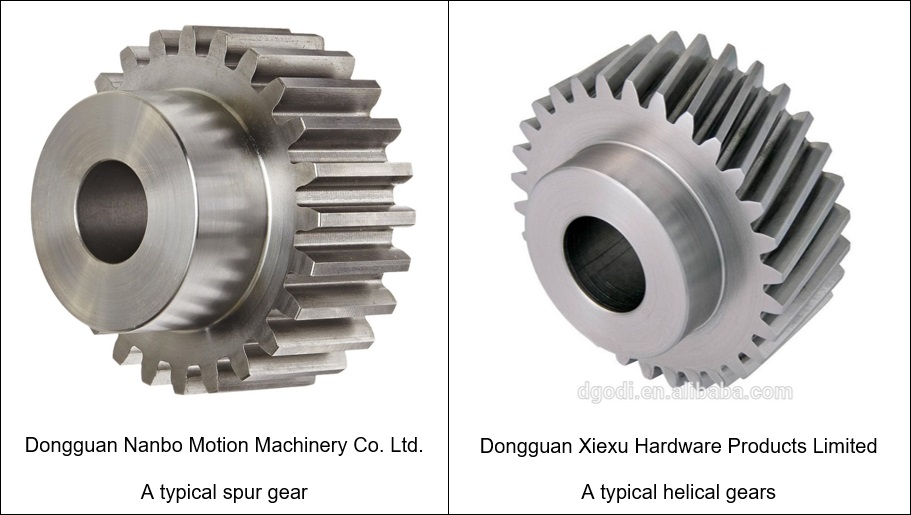Gear drive is one important mechanical power transmission element that can transmit power and motion from one shaft to another by means of toothed wheel rigidly mounted on the shafts. It is one engagement drive that indicates power transmission occurs by means of successive engagement and disengagement of teeth of two gears. Whereas the belt drive (one type of friction drive) is especially suitable for medium to long distance power transmission, gear drive is preferred when distance between two shafts (driver and driven) is small (usually below 0.5m). They offer positive drive (no slippage) and thus velocity ratio remains constant. Gear drives can transmit power and motion between two parallel shafts (spur and helical gears), two intersecting shafts (bevel gear) and also two non-parallel non-intersecting shafts (worm gear). Different types of gears are available to fulfill such requirements.
Based on the profile of the teeth and its orientation on the gear axis, gears can be classified into four basic groups—spur gear, helical gear, bevel gear and worm gear. When axes of driver and driven shafts are parallel and gear teeth are also cut parallel to the gear axis then it is called as spur gear. So it is suitable for transmitting power between two parallel shafts only. Another gear, called helical gear, can be used for transmitting power between two parallel shafts. In case of helical gear, the teeth are cut in the form of helix on the pitch cylinder of the gear blank. Thus teeth makes an angle (called helix angle) with the gear axis. As compared to spur gear, a pair of similar helical gears can transmit higher power and can also offer higher velocity reduction. It is also capable in reducing vibration and noise; however, at the higher fabrication cost. Various similarities and differences between spur gear and helical gear are tabulated below.

Similarities between spur gear and helical gear
- Both the gears are suitable for transmission of power and motion between parallel driver and driven shafts only. They cannot be used for non-parallel shafts.
- Both can provide positive drive (no slippage and thus constant velocity ratio). In contrast, belt drive cannot offer constant velocity ratio due to inherent slip and creep.
- Both are suitable for small distance power transmission (typically not above 0.5m).
- No flexible element exists between two gears. In both the cases, driver and driven gears remain in physical contact. This is unlike belt or chain drive where intermediate flexible element like chain or belt exists. Such flexible elements can absorb vibrations and thus can protect the driver unit from undesired vibrations induced in machines. Every gear drive fails to fulfill this task.
Differences between spur gear and helical gear
| Spur Gear | Helical Gear |
|---|---|
| In case of spur gear, teeth are parallel to the axis of the gear. | In case of helical gear, teeth are inclined with the gear axis in the form of a helix. This angle of inclination is known as helix angle (15° – 25°). |
| In spur gear drive, contact between teeth of two meshing gears occurs suddenly. | In helical gear drive, contact between teeth of meshing gears occurs gradually. |
| Here the contact between two meshing teeth is always a line of same length. | Here contact starts with a point, gradually becomes a line and leaves as a point. |
| Sudden engagement of teeth results in impact loading. So teeth are subjected to impact loading. | Due to gradual teeth engagement, load on the tooth builds up gradually. So teeth are subjected to gradual loading. |
| Impact loading caused by sudden engagement of teeth results vibration and noise. | Gradual loading provides a smooth and quite operation. |
| Load carrying capacity of spur gear is comparatively low. | For same size and same number of teeth, load carrying capacity of helical gear is comparatively high as larger number of teeth remains in contact at any instance. |
| Life of the spur gears is usually shorter. | Helical gears have longer life. |
| Two mating spur gears must have same module only. | Two mating helical gears must have same module, and same but opposite hand helix angle. |
| Spur gears are suitable for low to moderate speed applications. | Helical gears can be utilized at high speed also. |
| Spur gear drive produces only radial force. As the teeth are parallel to axis, the thrust force is zero. | Due to presence of helix angle, helical gear drive produces radial as well as thrust force. So the bearing must be capable of sustaining such thrust force. |
| It is suitable for the velocity ratio of 1:1 to 1:3. | It is suitable for the velocity ratio of 1:1 to 1:5. |
References
- Design of Machine Elements by V. B. Bhandari (Tata McGraw Hill Education Private Limited.
- A Textbook of Strength of Materials by R. K. Bansal (Laxmi Publications Private Limited).